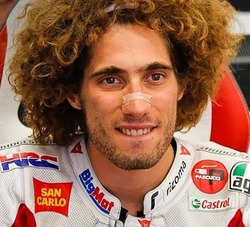Racing deaths teach us cruel lessons
 Sunday, October 23, 2011 at 3:07 PM
Sunday, October 23, 2011 at 3:07 PM It's been a tough week for race fans, with deaths of two major stars shaking our belief in sports that give us so much joy.
 Marco Simoncelli was known for his wild hair and wild abandon on the racetrack.Today brought the death of rising motorcycle-racing star Marco Simoncelli, just a week after Dan Wheldon lost his life in an IndyCar race.
Marco Simoncelli was known for his wild hair and wild abandon on the racetrack.Today brought the death of rising motorcycle-racing star Marco Simoncelli, just a week after Dan Wheldon lost his life in an IndyCar race.
Simoncelli was killed in a horrific MotoGP crash at Sepang. He was in fourth place when he lost control of his bike and was run over by another racer who had nowhere to go. The race was red flagged (SpeedTV's Dave Despain has a nice tribute to Simoncelli).
Wheldon died early into a very fast IndyCar race at Las Vegas Motor Speedway. I was at the track last Sunday, sitting high in the Turn 4 end of the front straightaway. The 15-car crash that took Wheldon's life was halfway across the track so it was hard to grasp the extent of Wheldon's injuries from so far away.
Today's IndyCars are relatively safe despite racing at 200-230 mph. And seeing car bodies explode on impact is actually a good thing; by design a chassis that breaks apart dissipates energy from the cockpit. So, drivers walk away from most crashes, even those at 220 mph.
But it didn't take too long to realize something was amiss last Sunday as track workers moved from a fast-paced cleanup to one more methodical, almost as if race officials had told them, "stretch it out." I've seen more than a hundred races of all types and had never seen death in person. But in my gut as I watched from the stands, I knew things were likely not going to end well. And so did the thousands of others around us, who were sharing rumors and checking their phones for any updates.
I've always shared the traditional race mantra that when death strikes, "the race must go on." But as I caught the first news of Wheldon's death on my smartphone -- long before the news was officially announced at the track -- I told my wife, "Let's go. Even if they restart, we're not going to enjoy it."
The race was indeed canceled, and when Las Vegas track officials announced they would offer full refunds for tickets, I shook my head, knowing that very few people would take up the promoters on a nice gesture. Death does not have a price.
So, one week has passed, and I'm online this morning and my eyes catch a photo of Simoncelli. I quickly look away because I don't want any details; I've recorded the race and want to watch it later. I smile, thinking Marco must have finally broken through and won an event in motorcycle racing's premier series. In reality, the photo was there to mark Simoncelli's passing, and as I watched the race it felt like a safe hit me in the chest when I watched Marco go down, his helmet bouncing along after his bike.
The race was quickly red flagged, and as was the case at Vegas, everyone watched and waited, hoping and praying a miracle would occur.
Sadly no, again.
Both Simoncelli and Wheldon were over-the-top personalities, talented athletes with charm and passion that made them must-see racers.
Simoncelli was fast and brave but unpredictable, a volatile mix that drew the ire of fellow MotoGP racers, including 2010 world champion Jorge Lorenzo. But, as fans, we loved the excitement Simoncelli brought to every race, and looked forward to what the future might bring as he polished his game.
Wheldon was older and more experienced. But having lost two full-time rides by overplaying his hand, he had become grounded with new wife and son, and was fighting his way back up the ladder. Even though he was a two-time Indy 500 champ, Wheldon was a part-timer, so last weekend's news he had signed a full-time 2012 ride with Andretti Motorsports had open-wheel fans smiling.
Racing is inherently dangerous, which is both an attraction and a curse. I watch because I enjoy the adrenaline, the sounds, the technology, the skill.
But two deaths in two weeks is hard to take for anyone, let alone fans and those actually on race teams. I'm left feeling very empty about racing, something I've followed closely for a quarter century.
I even found myself agreeing with parts of today's lengthy New York Times story examining whether IndyCar chief Randy Bernard is fit to lead the series. In most instances, I'd be bitching at the Times for giving IndyCar any attention only when controversy was at play -- and lead item on the front of the Sports cover, at that. Yet, today, I'm thinking, "Thanks for asking why Bernard has been AWOL for the last week."
I'm not sure any lessons can be learned from Simoncelli's accident, but here's hoping IndyCar learns that some tracks are unfit for the set-ups that allow IndyCars to corner at such high speeds. And that when bad news strikes, be upfront in talking about it. Silence breeds conspiracy.
Ultimately, the racing will go on and I expect I'll be watching front and center. In the meantime, I'll try to remember that life is short and surprise can sit around every corner, and that I should cherish every moment and live life now. If that sounds hackneyed, so be it. Sometimes it takes a few reminders for those lessons to sink in.

Reader Comments (1)
It sad to hear about his death. He maybe accomplished more with his talent in the racing world. Many will be miss you racing out there.